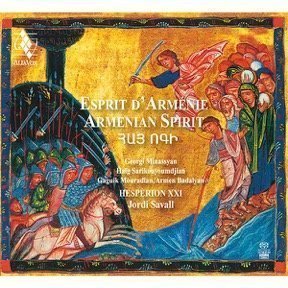ÉSPRIT D’ARMÉNIE
Armenian Spirit
Hespèrion XXI, Jordi Savall
15,99€
Reference: AVSA9892
- Georgi Minassyan
- Haïg Sarikouyoumdjian
- Gaguik Mouradian
- Armen Badalyan
- HESPÈRION XXI
- Jordi Savall
Armenia, one of the most ancient Eastern Christian civilisations, has miraculously survived a convulsive and peculiarly tragic history. Since its foundation, it has been surrounded politically and geographically by other great cultures with chiefly Eastern and Islamic beliefs, and has endured a cruel history punctuated by ruthless wars and massacres that have led to the disappearance of more than half its population, the exile of many others and the loss of major portions of its territory.
Armenia, one of the most ancient Eastern Christian civilisations, has miraculously survived a convulsive and peculiarly tragic history. Since its foundation, it has been surrounded politically and geographically by other great cultures with chiefly Eastern and Islamic beliefs, and has endured a cruel history punctuated by ruthless wars and massacres that have led to the disappearance of more than half its population, the exile of many others and the loss of major portions of its territory. Despite all this, throughout the centuries Armenia has preserved the essence of its national identity, first by the creation of its own alphabet (devised in 405 by the monk Mesrop Mashtots) and thanks to its rich architectural heritage, which is scattered beyond the country’s present-day borders. Although this tangible heritage is one of the most striking features of its nationhood, Armenia has also preserved a rich intangible heritage in the form of its music: a very rich and varied, albeit little known, repertory (except in the case of the duduk).
In all highly developed cultures, music – represented and embodied by certain instruments, as well as particular ways of singing and playing – is the most faithful spiritual reflection of a people’s soul and history. Of all the instruments used in its ancient musical traditions, Armenia has given special pride of place to a unique instrument, the duduk. It is no exaggeration to say that this instrument is the utmost expression of Armenia. As soon as we hear the sound of these instruments – they are usually played as a duo – the almost vocal quality and sweetness of their vibrations transport us to an extraordinary elegiac and poetic universe, introducing us to a dimension that is both intimate and profound. The music acts as a genuine balm, at once sensual and spiritual, which touches the human soul and gently heals all its wounds and sorrows.
+ information in the CD booklet
JORDI SAVALL
Versailles, 5th July 2012
Translated by Jacqueline Minett








Share